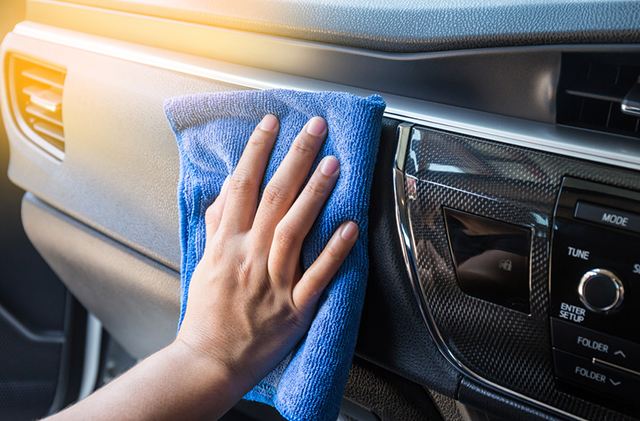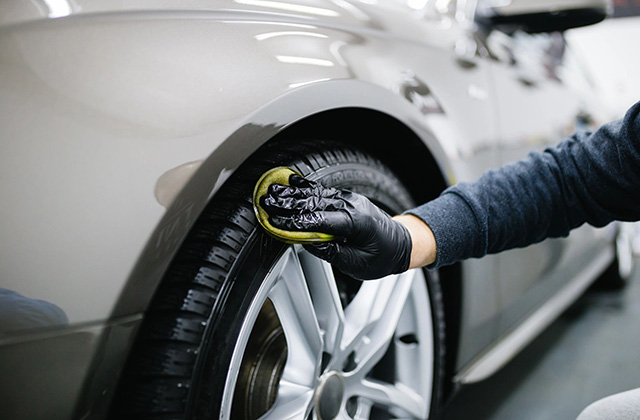What could be better than daily driving a classic car? Climbing in behind that perfectly thin steering wheel, hearing the carbureted engine rumble to life, then peering down over a long hood and taking the back roads to work would be more than enough to take the monotony out of the daily commute. Unfortunately, it’s never really that simple with an old car. Even if it’s in great shape, a classic car can be unpredictable, thirsty, and a handful to drive. Anything can go wrong with decades-old technology, and more often than not, something does. Luckily, a small but growing group of automakers around the world the are taking some of the most iconic cars ever built and resurrecting them as thoroughly modern machines built for today’s roads. We are always striving to provide the very best car interior cleaning products, along with vinyl buffing machine products.
At 2016’s Amelia Island Concours D’Elegance, a Florida-based startup called Revology made headlines when it introduced its first car: a 1966 Ford Mustang. This was no careful tribute or well-done restoration, but a completely new car with a modern powertrain, technology, and safety features hidden beneath an interior and sheet metal that made it almost indistinguishable from a 50-year-old car. And that’s what makes these reimagined classics so appealing; they have the benefit of hindsight. With modern engineering, they offer everything you’d want from a classic, and nothing you don’t. The bad brakes, clogged carburetors, mysterious leaks, electrical gremlins, and negotiating with the quirks of a half-century old machine disappear, and what you get instead is the Hollywood version of a classic car: all the show, all the go, and none of the headaches.
This new batch of modern classics are a far cry from the 1970s-era revival cars like the Excalibur SS and the Stutz Blackhawk, which offered woeful reinterpretations of pre-war classics and aged terribly. These new classics are blue-chip performance cars built by experts with a fanatic attention to detail. Revology was founded by Tom Scarpello, the former head of Ford’s Special Vehicles Team, and the company’s hand-built Mustangs have tacit approval from the Blue Oval. Starting with a Ford-licensed body built built by Dynacorn, the Revology Mustang borrows a 302 Windsor V8 from a 2000s-era Mustang, and shares its suspension with the fifth-generation 2005-2014 cars. Revology’s car uses so many genuine Ford parts that it can be serviced at any Ford dealership, and it also comes with a one-year factory warranty from Revology – Making it the first 1966 Mustang with a factory warranty since, well, 1966.
As Revology is busy building the superlative mid-century Mustang, across the country in Las Vegas, Shelby American has been carrying the torch for Ford’s other big 1960s performance legend. Looking to head off the kit car market in the 1980s, Carroll Shelby restarted production on his iconic Cobra roadster, and unlike the replicas, these modern Cobras come with an authentic Shelby “CSX” chassis number, just like the original 1960s models. Shelby offers the cars in both turn-key and kit form, but these Cobras are anything but your standard run-of-the-mill kit cars. The company’s recent anniversary models are near-perfect replicas of Shelby’s most important 1960s Cobras, right down to the black-faced Stewart-Warner gauges. Most models are fiberglass-bodied, but Shelby still offers cars with the period-correct aluminum bodies, too. Intent on bringing the Cobra into the 21st century, Shelby has also begun building carbon fiber-bodied cars to make the featherweight Cobra that much lighter.
While Revology and Shelby have Ford’s midcentury performance pretty well covered, Los Angeles-based Icon has taken the classic 1966-1975 Bronco and transformed it into one of the most durable off-roaders money can buy. Founded in 1996 as a restoration center for the iconic Toyota FJ40 Land Cruiser, by 2007, the company had hit on a winning concept that stripped the durable little Toyota down its body and frame, then loading it with some of the most advanced off-roading equipment in the world, creating the Icon FJ. In 2011, Icon followed the success of the FJ with the Icon BR, a reimagined first-generation Bronco designed to tackle some of the most rugged terrain in the world.
While the BR is faithful to the original Bronco’s rugged good looks, nothing carries over from the classic truck aside from its body and highly modified frame. Under the hood lies a 412 horsepower 5.0 liter engine from the modern Ford Mustang, and a custom suspension and massive solid axles make it one of the most capable off-roaders money can buy. All original brightwork has been removed in favor of custom aluminum and stainless steel trim especially developed for the BR. Inside, there is the option of seats covered in leather sourced from Mercedes-Benz, and all original instrumentation and hardware has been replaced with unique or aircraft-grade aluminum pieces. On top of the BR and the TJ, Icon also builds the TR, based on the 1947-1953 Chevrolet 3100 Thriftmaster pickup. Like the other two “production models,” the TR is all-new under its iconic exterior, and is one of the meanest looking street trucks on the road. Icon also has a Derelicts and Reformers department that transforms time-worn classics into some of the most advanced rat rods in the world. If you want an Icon truck, you’re not alone – there’s typically an 18-month waiting list for these ultimate off-roaders.
Of all the companies offering modern takes on classic cars, none of them have established as high a profile as Los Angeles-based Singer Vehicle Design. Despite a bold warning on its website that it isn’t affiliated with Porsche, and that its creations are expertly restored cars, the boutique company has quickly earned a world-wide reputation for crafting some of the greatest 911s in the world. While Icon eschews any semblance of “period-correctness” when it builds its trucks, Singer pulls from Porsche’s entire history to create a kind of “best of” package for the 1965-1997 air-cooled 911.
From a few feet away, the Singer-restored cars may look like they’re pristine 1965-1973 “long hood” 911s, but in reality, its cars are as modern as the 911s in a Porsche dealership. Singer starts with a clean 964 model 911, built from 1990-1994. The donor car is stripped down to its frame, and aside from the engine, it’s all Singer. The standard engine offered is a rebuilt Porsche 3.6 liter flat six, but its been stripped, blueprinted, and assembled by hand to put out 270 horsepower. While the 3.6 is a perfectly capable engine, Singer’s jewel is its 3.8 liter flat-six, which could be the best hotrodded Porsche engine ever built. With new rods, pistons, cylinder heads, and all-new fuel injection and engine management systems, this engine was co-developed with legendary British engine builders Cosworth, and give the Singer-modified 911 an impressive 370 horsepower – more than a modern water-cooled Porsche 911 Carrera.
From there, the Singer-restored 911s get a hand-built ultra lightweight carbon fiber body, an active rear spoiler (similar to a Bugatti Veyron) that deploys at speeds over 60 miles per hour, and an interior with a beautiful period-correct 1970s luxe look without any of the kitsch. The car’s star-shaped wheels may look like the iconic mid-century Fuchs alloys, but are an all-new aluminum design especially developed for the car. While Porsche has developed a reputation for building antiseptic, cold precision machines, these classics reimagined by Singer are a love letter to the company’s colorful past when it was playful enough to field a car at Le Mans called the “Pink Pig,” and offer a host of bold, flat colors that stood out from anything else on the roads. As formidable and achingly gorgeous as these machines are, above all else, they’re fun. Common to all the cars restored by Singer is the big orange center-mounted tach that sits nestled amid the jewel-like vintage VDO gauges and counts revs to 11, in homage to This Is Spinal Tap. While Singer redesigns the ultimate German car in Los Angeles, Americans aren’t the only ones bringing classics back from the dead, the trend is alive and well across the pond, too.
From tiny MGs to big, beautiful Aston Martin GT cars, the 1950s and 1960s were the golden age of British sports cars – until now, that is. While today British companies are offering some of the most formidable cars in the world, like the new McLaren 675LT and the Jaguar F-Type, a few small companies are at work to bring back two sports cars that bookended Britain’s golden era.
For some purists, the modern sports car era began at the 1961 Geneva Motor Show when Jaguar unveiled the E-Type. Everything from the gorgeous bodywork to the industrial-looking straight-six engine was like a work of art, and Enzo Ferrari put it simply when he said the Jag was “the most beautiful car ever made.” After production ended in 1975, every British sports car that’s come since has been held to the impossible standards set by the E-Type, and so far, nothing else has come close. Rather than compete with the legend, a small company called Eagle has decided to recreate them. The Eagle E-Type is completely hand-built. And while its E-Type features a host of upgrades under it gorgeous hand-built body that make it look like an original, it performs like a supercar made in 2015, not 1961. While the Eagle E-Types are unquestionably some of most beautiful hand-built cars in the world, they’re more exclusive than the original Jag ever was – the company has built fewer than 40 of the cars in the past 30 years.
By the 1970s, much of the magic had left the British auto industry, and few segments suffered more than its sports cars. The 1966-1976 Jensen Interceptor was a gorgeous Italian-designed grand tourer powered by a big American V8. While this sounds like a match made in heaven, the cars suffered from terrible build quality and were woefully unreliable. Still, the car’s good looks and incredible potential made it a prime candidate for a resurrection. Founded in 2010, Jensen International Automotive takes Icon’s approach to the iconic cars. Starting with an original car, the engine, interior, suspension, and brakes are all discarded in favor of new hardware. The original Chrysler V8 is replaced by a General Motors LS3 V8 found in the Chevrolet SS. The interior is modern and gorgeous, and overall, the Interceptor is transformed into a truly modern grand tourer wrapped in good looks that are enough to put some modern GT cars to shame.




